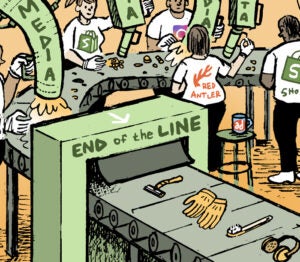 “On TV And Video” is a column exploring opportunities and challenges in advanced TV and video.
“On TV And Video” is a column exploring opportunities and challenges in advanced TV and video.
Today’s column is written by Mike Rosen, executive vice president of advanced advertising and platform sales at NBCUniversal Media.
Whether you’re planning a vacation or a media buy, we all know the difference between price and value and between cheap and efficient.
In both cases, data can help us make the right decision, but it doesn’t always tell the whole story. And lazy data – the misapplication or underutilization of data in media investment decisions – can actually lead us astray.
Having spent my formative years in the world of TV – first as a viewer, then as an ad buyer and now a seller – I have seen firsthand how easy it is for an industry to suffer from lazy data. When buying TV advertising, most still see audiences only through the lazy-data lens of age and gender, rather than the purchase and behavioral data that measures all aspects of the consumer path to purchase.
While digital media companies have claimed their data-enhanced products would solve the ills of legacy measurement, the digital folks got lazy in applying their data, starting a programmatic race to the bottom on price – while forgetting all about quality or effectiveness. It was easy for them to lean on more granular data as an end unto itself, but just because you can measure a media type better does not make the media itself better.
More broadly, our industry suffers from lazy data when it ignores key differences between ad platforms and products. Some act as if every media impression were the same for the sake of decision-making parity – turning high standards into simply standards, which then inevitably turn into lowest common denominators.
Ultimately, when false equivalency is combined with poisonous impressions from unsafe environments, the entire lazy-data model backfires, which is why we are now seeing another flight to quality, brand-safe premium video.
What’s more, lazy data makes it easier to confuse correlation and causation and justify the purchase of media that might simply be coincidental to the consumer journey, while masking the media that is doing the work of actually informing, inspiring or guiding it.
Right now, we are too quick to ascribe a single, definitive winner in the game of ad effectiveness, with last-touch attribution being the most virulent form of this. Too often, last-touch is used to claim advertising victory, not unlike awarding the Olympic gold to only one member of a relay team based not on actual performance, but the runner who last held the baton.
Lazy data doesn’t serve advertisers, but the great news is that the advertising industry now has a treasure trove of hard-working data at its keyboard fingertips. Now the key is to apply that data thoughtfully, which means looking for ingredients rather than simple answers.
AdExchanger Daily
Get our editors’ roundup delivered to your inbox every weekday.
Daily Roundup
If we imagine advertising like chemistry, we’re always looking for the right combination of elements that lead to predictable outcomes. The better the data, the less “magical” the formula is and the more reliable and repeatable it becomes. And the more we consider context, relevancy, brand safety, environment, engagement, storytelling, emotional connection and credibility – all the ingredients that matter – the more likely we are to reverse this lazy-data trend.
Despite the fact that the first of a million industry acronyms I ever learned was CPM, it has never really been about that. Our industry needs to stop being lazy and refocus its data efforts on delivering the maximum return on advertising.
Follow NBCUniversal Media (@NBCUniversal) and AdExchanger (@adexchanger).












